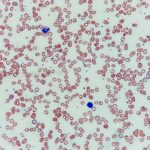
The pillars of treatment in thalassemias include managing anemia, improving ineffective hematopoiesis, preventing and managing end-organ damage, and iron overload with its complications. It is helpful to divide thalassemia into non-transfusion-dependent thalassemia (NTDT) and transfusion-dependent thalassemia (TDT) when considering these conditions’ clinical complications and management. Many complications could be seen in patients with thalassemias.
The figure below shows the different complications that could be seen according to TDT vs NTDT:

The TDT complications are mostly related to iron overload related to the number of transfusions required by patients. These complications are similar to the clinical features seen in patients with hemochromatosis (we will review hemochromatosis in a future post). The NTDT complications are similar to those seen in patients with sickle cell disease including leg ulcers, pulmonary hypertension, right ventricular (RV) dysfunction, venous thromboembolism, microvascular disease, and cholelithiasis, among others. Importantly, these complications overlap between the two classifications.
Management of Thalassemias
Treatment of thalassemias is geared towards two important pathophysiologic issues including anemia and iron overload. Blood transfusions improve symptoms of anemia and decrease the complications of ineffective hematopoiesis.
Management of Non-Transfusion Dependent Thalassemia (NTDT)
The clinical features and severity of NTDT can vary widely. Therefore, it is important to individualize treatment. Patients with NTDT can convert into TDT depending on their degree of anemia and clinical symptoms. The management of NTDT (formerly called thalassemia intermedia) includes:
- Blood transfusions: Consider when hemoglobin decreases to <6 g/dL during acute events such as infections or surgery, or in pregnancy. Transfusions improve ineffective hematopoiesis decrease hemolysis and help prevent complications from NTDT. Therefore, NTDT patients who develop complications as previously described above should be considered for a chronic transfusion program to improve ineffective hematopoiesis and hemolysis.
- Hydroxyurea: In some patients who do not require yet chronic transfusions or are not interested in receiving transfusions, hydroxyurea can be considered to increase hemoglobin > 1g/dL.
- Iron overload: Patients with thalassemia major and intermedia can develop iron overload due to anemia. The iron overload can worsen with frequent transfusions. Therefore, all patients with these conditions should have iron assessments regularly. The two most common ways for estimating iron storage include:
- Serum ferritin level: Consider iron chelation with deferasirox when the serum ferritin level is above 1000 ng/mL. In clinical practice, following the trends of ferritin is important as it is an acute phase reactant and could change with certain conditions such as acute infections and inflammation.
- Liver iron content (LIC): The liver iron content can be measured by a T2* MRI technique. If the LIC score is 5 or more, consider iron chelation as well.
- Cardiac iron content (CIC): Similar to LIC, uses T2* and other techniques to measure the iron content in the heart. The normal value for ICI is >20 msec. Therefore, a T2* of <20 msec indicates iron overload. Accumulation of iron can vary from organ to organ and it is recommended to monitor both in clinical practice if available.
- Splenectomy: Increases the risk of thrombosis, organ infarcts, pulmonary hypertension, leg ulcers, and others. Therefore, splenectomy is only done when necessary and avoided in the initial management of the disease.

Reference: Saliba et al. DOI: 10.1182/blood.2023020685 – American Society of Hematology 2024
Management of Transfusion-Dependent Thalassemias
TDT in general refers to patients with thalassemia major or those with thalassemia intermedia that transform from NTDT to TDT. Most of these patients develop anemia and symptoms early in life and are managed by pediatricians. The main goals in the management of TDT are transfusion support, management of iron overload, and treatment of end-organ damage and complications.
Transfusion Support
Patients with thalassemia major usually require frequent transfusions and are enrolled in chronic transfusion programs. The indications to initiate transfusion support include:
- Thalassemia major + severe anemia: Hemoglobin ≦6 g/dL at least on two separate occasions separated by two weeks.
- Significant symptoms of anemia
- Poor growth or failure to thrive
- Complications of ineffective hematopoiesis: facial changes, bone fractures, bony masses from extramedullary hematopoiesis, etc.
- Organomegaly from hematopoiesis such as hepatosplenomegaly.
The goal of transfusions is to maintain a pre-transfusion hemoglobin of 9.5-10.5. Transfusions are usually required every 2-4 weeks but may vary from patient to patient. Importantly, the risk of alloimmunization and hemolytic transfusion reactions is high (up to 37% of patients). To prevent alloimmunization, consider transfusions with C, E, Kell matched red blood cell products.
Management of Iron Overload – Iron Chelation
Similar to NTDT patients, it is important to test and monitor iron content and manage overload with iron chelation as the body does not have a mechanism to excrete excess iron. Iron chelation is usually started after 20 packed red blood cell (PRBC) transfusions or when there are signs of iron overload (ferritin above 1000 or increased iron content in liver and/or cardiac tissue by imaging). The goal of chelation is to maintain a ferritin level <1000 and decrease the iron content in the liver and/or heart by MRI assessment. The main options for iron chelation include:
| Characteristics | Deferoxamine | Deferasirox | Deferiprone |
|---|---|---|---|
| Route of administration | IV or subcutaneous | Oral | Oral |
| Main Side Effects | Monitor CBC, renal, and liver profiles once a week initially | Gastrointestinal (nausea, vomiting, diarrhea) Liver and renal dysfunction | Agranulocytosis (<1% of patients) Gastrointestinal (nausea, vomiting, diarrhea) |
| Decrease in liver iron | +++ | +++ | ++ |
| Decrease in cardiac iron | ++ | ++ | +++ (best option for cardiac iron overload and dysfunction) |
| Monitoring | Monitor CBC, renal, and liver profile every 2-4 weeks | Monitor CBC, renal, and liver profile once a week initially | Monitor CBC and liver and renal profile weekly (need to check neutrophil counts) |
| Costs | + | +++ | ++ |
Other Therapies for Thalassemias
Luspatercept
Luspatercept is a modified activin receptor type IIB (ActRIIB) fusion protein that reduces erythroid hyperplasia and promotes RBC precursor differentiation by blocking Activin A and transforming growth factor B (TGF-B). Luspatercept is used to decrease the transfusion requirements in TDT and could be considered in those patients who transform from NTDT to TDT. Here are the main characteristics to remember about luspatercept:
- Route of administration: Subcutaneous injection (1-1.25 mg/kg) every 3 weeks
- Side effects: headaches, musculoskeletal pains, fatigue, dizziness, thrombosis, hypertension, and extramedullary hematopoiesis (avoided in patients with bone masses or lesions, face deformities, and other bone structural abnormalities).
- Trial: Phase 3 randomized controlled trial BELIEVE (NEJM 2020). The study achieved ≧30% reduction in transfusion burden in weeks 13-24.
Pyruvate Kinase Activators
Pyruvate kinase activators such as mitapivat and etavopivat are being studied for use in patients with alpha and beta thalassemias. Levels of ATP enzyme in thalassemia patients are low and these agents increase their pyruvate kinase activity increasing the availability of ATP and improving RBC production. Mitapivat is a medication used in pyruvate kinase deficiency. The phase 2 study of mitapivat in patients with NTDT showed an increase in hemoglobin >1 g/dL from baseline weeks 4-12 in 80% of patients.
Stem Cell Transplantation (SCT)
Stem cell transplantation is the only curative option and younger patients tend to have better outcomes. Furthermore, the best option is a matched sibling donor. The goal of SCT is to replace the patient’s defective stem cells with healthy donor cells that can produce normal hemoglobin. HSCT has a high cure rate, with long-term disease-free survival rates exceeding 80-90% in selected young patients.
Gene Modification Therapy
Gene therapy is an emerging option for the treatment of thalassemias. The goal is to correct the genetic defect responsible for thalassemia, offering a potential cure without the need for donor stem cells. In gene therapy, the patient’s hematopoietic stem cells (HSCs) are used to introduce a functional beta-globin gene or reactivate fetal hemoglobin (HbF) production. The process involves using lentiviral vectors or CRISPR-Cas9 gene editing. The modified cells are reinfused into the patient after conditioning, allowing them to produce healthy red blood cells with normal or improved hemoglobin. One of the first products was Zynteglo which has shown success in reducing or eliminating the need for blood transfusions in beta thalassemia patients. Importantly, gene therapy is expensive and only available in a few selected centers. Therefore, it is still not available for most patients in the world but hopefully, it continues to be investigated and used in clinical practice.
We hope you enjoyed this post! Please, leave us any comments or questions below. Rate our post using the star system below if your time allows.
Thank you for reading!





